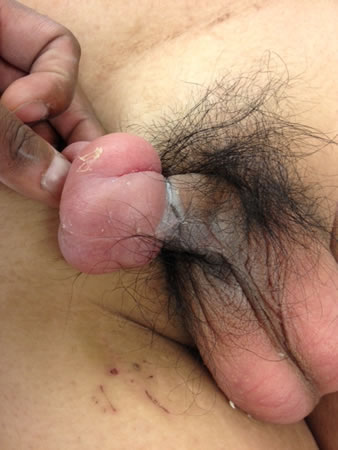History and exam
Key diagnostic factors
common
penile pain
Adult patients will most often report penile pain.
band of retracted foreskin tissue beneath the glans
A constricting band of tissue will be observed directly behind the head of the penis. [Figure caption and citation for the preceding image starts]: ParaphimosisFrom the collection of Dr Ranjiv Mathews [Citation ends]. [Figure caption and citation for the preceding image starts]: Paraphimotic ringFrom the collection of Dr Ranjiv Mathews [Citation ends].
[Figure caption and citation for the preceding image starts]: Paraphimotic ringFrom the collection of Dr Ranjiv Mathews [Citation ends].
swollen glans penis
This is enlarged and congested with a collar of edematous foreskin. The shaft of the penis is not swollen.
indwelling catheter
Many patients will have an indwelling catheter. After the reason for the placement of the catheter has been determined, the catheter should be removed before attempting reduction of the paraphimosis.
Other diagnostic factors
common
erythema
There may be redness.
uncommon
black tissue on the glans
This is a concern for the presence of early necrosis.
nonpliable glans penis
This is a concern for the presence of early necrosis.
inability to urinate freely
Pediatric patients may report symptoms of obstructive voiding.
Risk factors
strong
lack of circumcision
This is the primary cause for the development of paraphimosis. The condition does not occur in circumcised men.
urinary catheterization
The most common cause of paraphimosis is urinary catheterization when, after inserting the catheter, there is failure to replace the foreskin over the glans after the procedure.[6]
dependence on a caregiver for daily hygiene
These patients are at risk for paraphimosis. Problems arise when the foreskin is not returned to its original position following retraction to permit appropriate cleaning or for catheter insertion.
tight foreskin
If a tight foreskin is forcibly drawn back (e.g., during intercourse), it may become trapped behind the glans penis and cause paraphimosis.
phimosis
Pathologic phimosis exists when failure to retract is secondary to distal scarring of the prepuce. This scarring often appears as a contracted white fibrous ring around the preputial orifice.[1] Narrow opening of the foreskin is a strong correlate for the development of paraphimosis. The density of the phimotic ring determines the degree of vascular compromise that develops. The denser the ring, the greater the degree of the vascular engorgement, eventual vascular compromise, and potential for necrosis of the glans.
poor hygiene
This makes the condition more likely.
bacterial infection
The existence of recurrent bouts of bacterial infection (balanoposthitis) makes paraphimosis more likely.
parasitic infections
Infections such as filariasis, which impair lymphatic drainage, can cause paraphimosis.
lichen sclerosis
This condition primarily affects the foreskin, leading to loss of skin coloration, scarring, and tightness.[15]
diabetes
Chronic conditions such as diabetes can lead to recurrent episodes of penile infection and eventual phimosis. This increases the potential risk for the development of paraphimosis. In addition, diabetes increases the likelihood of ensuing necrosis.[16]
penile piercing
This can cause paraphimosis.[9]
hemangiomas of the penis
These can cause paraphimosis.[12]
weak
peripheral vascular disease
Chronic conditions such as peripheral vascular disease can lead to recurrent episodes of penile infection and eventual phimosis. This increases the potential risk for the development of paraphimosis. In addition, peripheral vascular disease increases the likelihood of ensuing necrosis.[16]
inadequate circumcision
This can cause paraphimosis.
Use of this content is subject to our disclaimer